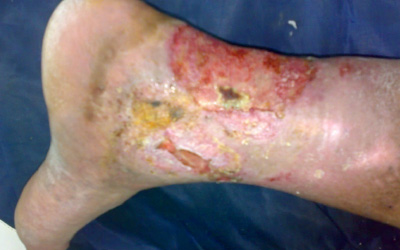
A Cambridge study has found that most inpatients with leg ulcers were not referred to a vascular surgery team, indicating a need to improve pathways of care for inpatients with leg ulcerations.
The results of the study conducted at Addenbrooke’s hospital, Cambridge, UK, were presented at the Royal Society of Medicine’s Venous Forum annual meeting (RSMVF; 25–26 June, London, UK) by Edward Lewis, fifth year medical student, University of Cambridge, UK.
According to Lewis, leg ulcers are an increasing problem in the Westernised world. The associated health costs are significant and treatment is suboptimal, often resulting in limb amputations. The management of leg ulcers involves medical optimisation and urgent vascular surgical input. However, he noted, patients are often not identified early, so this study was conducted to discover the prevalence of leg ulcers in Addenbrooke’s hospital.
“We wondered whether there was a hidden burden of leg ulcer disease in the hospital which should be picked up by inpatient services. So we wanted to ascertain the burden of this disease in the inpatient population of a large teaching hospital,” Lewis explained.
On a single day (4 January 2018) the entire inpatient population of Addenbrooke’s hospital was analysed. Using the hospital’s computer system (EPIC), every patient had their record search using the terms “ulcer”, “leg ulcer” and “foot ulcer”. Any patient who was younger than 55-years-old was excluded. Each patient’s notes were reviewed to confirm an active leg ulcer and any medical comorbidities. The data collected included the ward, age and diabetes diagnosis.
Lewis reported that of the 979 patients in Adenbrooke’s hospital, 733 (74.9%) were eligible for inclusion. Of these, 75 (10.2%) had a current leg ulcer. Thirty nine of these patients had a diagnosis of diabetes, equalling 52%.
“Only 16 of these 75 patients were on a vascular surgery or diabetic foot ward, indicating that there was a large portion of this population who were not under direct care and may not have been referred appropriately,” Lewis maintained.
Unhealing leg ulcers cost the UK National Health Service £3.2 billion/year (Guest et al 2015). This study showed that diabetes contributes in up to half of patients’ ulcers.
“In conclusion, we have discovered a very high burden of lower extremity ulcers in an inpatient population. A lot of these patients were not under a vascular surgery or tissue viability team. We therefore show that there is a definite need to improve patient pathways for referral in order that these inpatients can access vascular surgery services easily,” Lewis reported.
He added that what the research team is working on now is an algorithm for a referral pathway that can be used by healthcare professionals to expediate referrals. “We realise that if all of these patients identified with an ulcer were referred, this would overwhelm the vascular surgery services. This algorithm provides a useful tool so that we can stratify the patients who need urgent referral and those who can be delayed. Ultimately, we want to make sure that those patients have the right referral at the right time,” Lewis said.








